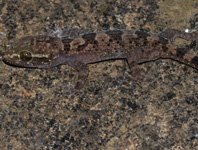Abstract
We describe a new species of the Hemidactylus acanthopholis clade from Sirumalai, an isolated massif in the Dindigul district of Tamil Nadu state, India. Hemidactylus sirumalaiensis sp. nov. can be diagnosed from all members of the prashadi group by its medium body size (SVL <95 mm), the number of dorsal tubercles rows at mid-body, the number of enlarged tubercles in paravertebral rows, the number of femoral pores and poreless scales between series of left and right femoral pores on the femoral-precloacal row in males, the number of ventral scales across the belly at mid-body and subtle colour pattern differences. The new species is the fourth member of the acanthopholis clade and 8.5–13.4 % divergent in ND2 sequence data from other members of the clade. We also provide data on additional specimens from a new locality of Hemidactylus kolliensis, previously known only from the male holotype. Hemidactylus sirumalaiensis sp. nov. is the first endemic and only the other vertebrate species described from Sirumalai massif in the last 133 years. Most rupicolous Hemidactylus species from peninsular India outside the Western Ghats are known only from a few localities and are likely to be geographically restricted in distribution, and large areas of suitable habitat remain unsurveyed, suggesting many more allied species remain to be discovered.
References
Agarwal, I., Giri, V.B. & Bauer, A.M. (2011) A new cryptic rock-dwelling Hemidactylus (Squamata: Gekkonidae) from south India. Zootaxa, 2765 (1), 21–37.
https://doi.org/10.11646/zootaxa.2765.1.2
Agarwal, I., Khandekar, A., Giri, V.B., Ramakrishnan, U. & Karanth, P.K. (2019b) The hills are alive with geckos! A radiation of a dozen species on sky islands across peninsular India (Squamata: Gekkonidae, Hemiphyllodactylus). Organisms Diversity & Evolution, 19, 341–361.
https://doi.org/10.1007/s13127-019-00392-5
Agarwal, I., Bauer, A.M., Giri, V.B. & Khandekar, A. (2019a) An expanded ND2 phylogeny of the brookii and prashadi groups with the description of three new Indian Hemidactylus Oken (Squamata: Gekkonidae). Zootaxa, 4619 (3), 431–458.
https://doi.org/10.11646/zootaxa.4619.3.2
Bansal, R. & Karanth, K.P. (2010) Molecular phylogeny of Hemidactylus geckos (Squamata: Gekkonidae) of the Indian subcontinent reveals a unique Indian radiation and an Indian origin of Asian house geckos. Molecular Phylogenetics and Evolution, 57, 459–465.
https://doi.org/10.1016/j.ympev.2010.06.008
Batuwita, S. & Pethiyagoda, R. (2012) Rediscovery of the Sri Lankan ‘house gecko’ Hemidactylus pieresii Kelaart (Reptilia: Gekkonidae) with a redescription of Hemidactylus depressus Gray. Zootaxa, 3359 (1), 17–30.
https://doi.org/10.11646/zootaxa.3359.1.2
Bauer, A.M., Jackman, T.R., Greenbaum, E., Giri, V. & De Silva, A. (2010) South Asia supports a major endemic radiation of Hemidactylus geckos. Molecular Phylogenetics and Evolution, 57, 343–352.
https://doi.org/10.1016/j.ympev.2010.06.014
Carranza, S. & Arnold, E.N. (2006) Systematics, biogeography, and evolution of Hemidactylus geckos (Reptilia: Gekkonidae) elucidated using mitochondrial DNA sequences. Molecular Phylogenetics and Evolution, 38, 531–545.
https://doi.org/10.1016/j.ympev.2005.07.012
Chaitanya, R., Lajmi, A. & Giri, V.B. (2018) A new cryptic, rupicolous species of Hemidactylus Oken, 1817 (Squamata: Gekkonidae) from Meghamalai, Tamil Nadu, India. Zootaxa, 4374 (1), 49–70.
https://doi.org/10.11646/zootaxa.4374.1.3
Ganesh, S.R. & Arumugam, M. (2016) Species richness of montane herpetofauna of southern Eastern Ghats, India: A historical resume and a descriptive checklist. Russian Journal of Herpetology, 23, 7–24.
Ganesh, S.R., Rameshwaran, M., Naveen, A. J. & Ahamed M.J. (2017) On two little-known terrestrial South Asian geckoes Hemidactylus reticulatus and Hemidactylus scabriceps (Reptilia: Gekkonidae). Journal of Threatened Taxa, 9, 10171–10177.
https://doi.org/10.11609/jott.3163.9.5.10171-10177
Giri, V.B., Bauer, A.M., Mohapatra, P.P., Srinivasulu, C. & Agarwal, I. (2017) A new species of large-bodied, tuberculate Hemidactylus Oken (Squamata: Gekkonidae) from the Eastern Ghats, India. Zootaxa, 4347 (2), 331–345.
https://doi.org/10.11646/zootaxa.4347.2.8
Lajmi, A., Verma, V. & Karanth, P. (2019) Repeated evolution of terrestrial lineages in a continental lizard radiation. Journal of Evolutionary Biology, 33 (1), 57–66.
https://doi.org/10.1111/jeb.13544
Macey, J.R., Larson, A., Ananjeva, N.B., Fang, Z. & Papenfuss, T.J. (1997) Two novel gene orders and the role of light-strand replication in rearrangement of the vertebrate mitochondrial genome. Molecular Biology and Evolution, 14, 91–104.
https://doi.org/10.1093/oxfordjournals.molbev.a025706
Mirza, Z.A. & Sanap, R. (2014) New cryptic species of gecko of the genus Hemidactylus Oken, 1817 (Reptilia: Gekkonidae) from Southern India. Taprobanica, 6, 12–20.
https://doi.org/10.4038/tapro.v6i1.7056
Mirza, Z.A., Bhosale, B. & Patil, R. (2017) A new large species of gecko of the genus Hemidactylus Oken, 1817 (Reptilia: Sauria: Gekkonidae) from the Eastern Ghats, India. Comptes Rendus Biologies, 340, 531–540.
https://doi.org/10.1016/j.crvi.2017.09.003
Mirza, Z.A., Gowande, G.G., Patil, R., Ambekar, M. & Patel, H. (2018) First appearance deceives many: disentangling the Hemidactylus triedrus species complex using an integrated approach. PeerJ, 6, e5341.
https://doi.org/10.7717/peerj.5341
Raheem, D., Taylor, H., Ablett, J., Preece, R., Aravind, N. & Naggs, F. (2014). A systematic revision of the land snails of the Western Ghats of India. Tropical Natural History, 4, 1–294. [https://tci-thaijo.org/index.php/tnh/article/view/103091]
Silvestro, D. & Michalak, I. (2012) raxmlGUI: A graphical front-end for RAxML. Organisms, Diversity and Evolution, 12, 335–337.
https://doi.org/10.1007/s13127-011-0056-0
Srikanthan, A.N., Kumar, G.C., Urs, A.J. & Ganesh, S.R. (2018a) Appearances are deceptive: molecular phylogeny recovers the Scaly Gecko Hemidactylus scabriceps (Reptilia: Squamata: Gekkonidae) as a member of a scansorial and rupicolous clade. Journal of Threatened Taxa, 10, 12147–12162.
https://doi.org/10.11609/jott.3964.10.9.12147-12162
Srikanthan, A.N., Swamy, P., Mohan, A.V. & Pal, S. (2018b) A distinct new species of riparian rock-dwelling gecko (genus: Hemidactylus) from the southern Western Ghats. Zootaxa, 4434 (1), 141–157.
https://doi.org/10.11646/zootaxa.4434.1.9
Srinivasulu, C., Srinivasulu, A. & Kumar, G.C. (2018) A new cryptic rock-dwelling Hemidactylus Oken, 1817 (Squamata: Gekkonidae) from northern Karnataka, India. Zootaxa, 4444 (1), 25–42.
https://doi.org/10.11646/zootaxa.4444.1.2
Stamatakis, A. (2006) RAxML-VI-HPC: maximum likelihood-based phylogenetic analyses with thousands of taxa and mixed models. Bioinformatics, 22, 2688–2690.
https://doi.org/10.1093/bioinformatics/btl446
Tamura, K., Peterson, D., Peterson, N., Stecher, G., Nei, M. & Kumar, S. (2011) MEGA5: Molecular evolutionary genetics analysis using maximum likelihood, evolutionary distance, and maximum parsimony methods. Molecular Biology and Evolution, 28, 2731–2739.
https://doi.org/10.1093/molbev/msr121
Uetz, P., Freed, P. & Hosek, J. (2020) The Reptile Database. Available from: http://www.reptile-database.org (accessed 19 April 2020)


